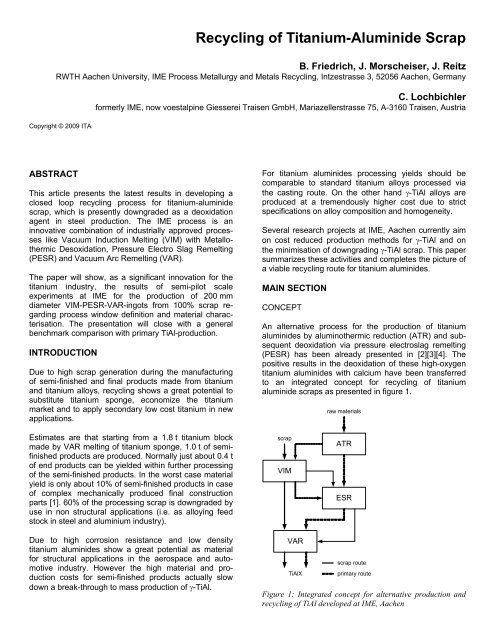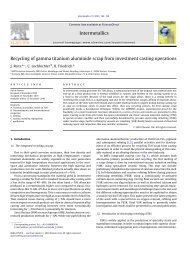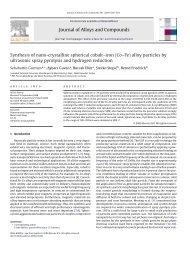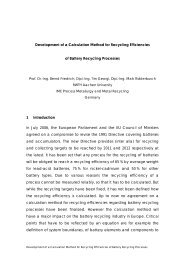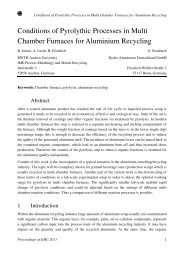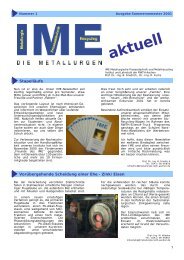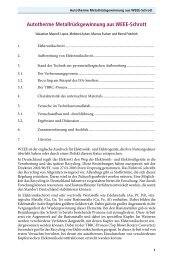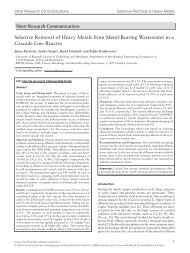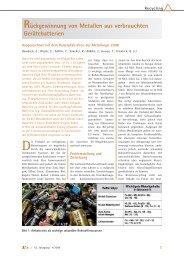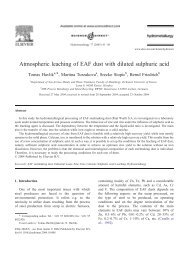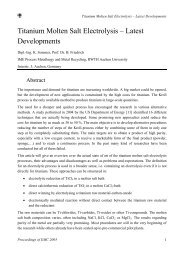Recycling of Titanium-Aluminide Scrap - RWTH
Recycling of Titanium-Aluminide Scrap - RWTH
Recycling of Titanium-Aluminide Scrap - RWTH
You also want an ePaper? Increase the reach of your titles
YUMPU automatically turns print PDFs into web optimized ePapers that Google loves.
<strong>Recycling</strong> <strong>of</strong> <strong>Titanium</strong>-<strong>Aluminide</strong> <strong>Scrap</strong><br />
B. Friedrich, J. Morscheiser, J. Reitz<br />
<strong>RWTH</strong> Aachen University, IME Process Metallurgy and Metals <strong>Recycling</strong>, Intzestrasse 3, 52056 Aachen, Germany<br />
Copyright © 2009 ITA<br />
ABSTRACT<br />
C. Lochbichler<br />
formerly IME, now voestalpine Giesserei Traisen GmbH, Mariazellerstrasse 75, A-3160 Traisen, Austria<br />
This article presents the latest results in developing a<br />
closed loop recycling process for titanium-aluminide<br />
scrap, which is presently downgraded as a deoxidation<br />
agent in steel production. The IME process is an<br />
innovative combination <strong>of</strong> industrially approved processes<br />
like Vacuum Induction Melting (VIM) with Metallothermic<br />
Desoxidation, Pressure Electro Slag Remelting<br />
(PESR) and Vacuum Arc Remelting (VAR).<br />
The paper will show, as a significant innovation for the<br />
titanium industry, the results <strong>of</strong> semi-pilot scale<br />
experiments at IME for the production <strong>of</strong> 200 mm<br />
diameter VIM-PESR-VAR-ingots from 100% scrap regarding<br />
process window definition and material characterisation.<br />
The presentation will close with a general<br />
benchmark comparison with primary TiAl-production.<br />
INTRODUCTION<br />
Due to high scrap generation during the manufacturing<br />
<strong>of</strong> semi-finished and final products made from titanium<br />
and titanium alloys, recycling shows a great potential to<br />
substitute titanium sponge, economize the titanium<br />
market and to apply secondary low cost titanium in new<br />
applications.<br />
Estimates are that starting from a 1.8 t titanium block<br />
made by VAR melting <strong>of</strong> titanium sponge, 1.0 t <strong>of</strong> semifinished<br />
products are produced. Normally just about 0.4 t<br />
<strong>of</strong> end products can be yielded within further processing<br />
<strong>of</strong> the semi-finished products. In the worst case material<br />
yield is only about 10% <strong>of</strong> semi-finished products in case<br />
<strong>of</strong> complex mechanically produced final construction<br />
parts [1]. 60% <strong>of</strong> the processing scrap is downgraded by<br />
use in non structural applications (i.e. as alloying feed<br />
stock in steel and aluminium industry).<br />
Due to high corrosion resistance and low density<br />
titanium aluminides show a great potential as material<br />
for structural applications in the aerospace and automotive<br />
industry. However the high material and production<br />
costs for semi-finished products actually slow<br />
down a break-through to mass production <strong>of</strong> γ-TiAl.<br />
For titanium aluminides processing yields should be<br />
comparable to standard titanium alloys processed via<br />
the casting route. On the other hand γ-TiAl alloys are<br />
produced at a tremendously higher cost due to strict<br />
specifications on alloy composition and homogeneity.<br />
Several research projects at IME, Aachen currently aim<br />
on cost reduced production methods for γ-TiAl and on<br />
the minimisation <strong>of</strong> downgrading γ-TiAl scrap. This paper<br />
summarizes these activities and completes the picture <strong>of</strong><br />
a viable recycling route for titanium aluminides.<br />
MAIN SECTION<br />
CONCEPT<br />
An alternative process for the production <strong>of</strong> titanium<br />
aluminides by aluminothermic reduction (ATR) and subsequent<br />
deoxidation via pressure electroslag remelting<br />
(PESR) has been already presented in [2][3][4]. The<br />
positive results in the deoxidation <strong>of</strong> these high-oxygen<br />
titanium aluminides with calcium have been transferred<br />
to an integrated concept for recycling <strong>of</strong> titanium<br />
aluminide scraps as presented in figure 1.<br />
scrap<br />
VIM<br />
VAR<br />
TiAlX<br />
raw materials<br />
ATR<br />
ESR<br />
scrap route<br />
primary route<br />
Figure 1: Integrated concept for alternative production and<br />
recycling <strong>of</strong> TiAl developed at IME, Aachen
In this concept, the preliminary melting <strong>of</strong> scrap is done<br />
by conventional VIM using specialized ceramic linings.<br />
This includes pre-deoxidization by metallothermic<br />
reaction with calcium metal. The second process step is<br />
final deoxidization by PESR using a continuously reactivated<br />
Ca-containing slag. Finally VAR removes small<br />
slag inclusions as well as dissolved Ca and allows for<br />
hydrogen degassing. For each step special equipment<br />
requirements and metallurgical challenges are inherent<br />
and lead to different refining opportunities.<br />
MELTING AND DEOXIDATION BY VIM<br />
The titanium activity in Ti-Al-melts is significantly lower<br />
(aTi ~ 0,2-0,3) compared to pure titanium melts and with<br />
~1550°C, the melting point is around 100°C lower<br />
compared to pure titanium. Because <strong>of</strong> these facts and<br />
in spite <strong>of</strong> the well-known chemical aggressiveness <strong>of</strong><br />
titanium melts towards oxide crucibles, scrap melting<br />
can be conducted in conventional vacuum induction<br />
furnaces using oxide based refractories. This ensures<br />
economy due to strongly increased energy efficiency<br />
compared to a highly sophisticated titanium recycling<br />
metallurgy based on water-cooled copper moulds<br />
(CHEBM) or “cold crucibles” (Induction Skull Melting).<br />
The application <strong>of</strong> conventional VIM <strong>of</strong>fers best chemical<br />
homogenisation due to inductive stirring, composition<br />
adjustment via hot sampling and alloy charging,<br />
excellent heat control and heat distribution due to direct<br />
heating by induced eddy currents, hence a controlled<br />
evaporation <strong>of</strong> volatile elements and finally a high<br />
flexibility regarding feed material (shape, dimension,<br />
number <strong>of</strong> scrap and primary materials).<br />
In order to evaluate and control the chemical and<br />
thermal stability <strong>of</strong> different refractory linings and the<br />
corresponding oxygen pick-up during the melt, thermochemical<br />
modelling is applied. Target is the calculation<br />
<strong>of</strong> the thermochemical equilibrium (i.e. oxygen content <strong>of</strong><br />
liquid metal phase) as a function <strong>of</strong> process temperature<br />
and crucible material. The procedure consists in searching<br />
the minimum <strong>of</strong> total Gibbs energy Gtot <strong>of</strong> the<br />
considered system and accordingly to the change in free<br />
Gibbs energy <strong>of</strong> reaction ΔG R = 0 for equation (1) which<br />
represents the reaction <strong>of</strong> a TiAl melt with an oxide<br />
based refractory.<br />
α + (X) = α-δ + (XMem·δOn·δ) (1)<br />
with: - solid crucible material (e.g. Al2O3),<br />
(X) - liquid Ti or Ti/TiAl alloy, δ - extent <strong>of</strong> reaction with<br />
δ [0, α]<br />
Figures 2 and 3 show the results <strong>of</strong> the thermochemical<br />
modelling based on data from Factsage ® (Version 5.5) in<br />
case <strong>of</strong> unalloyed titanium respectively binary γ-TiAl (50<br />
at.% Al) and pure alumina (Al2O3) as crucible material.<br />
As can be observed in figure 2, there is no equilibrium<br />
reached within the considered extend <strong>of</strong> reaction. The<br />
total amount <strong>of</strong> alumina will be dissolved in titanium and<br />
the final oxygen content is only limited by the dissolved<br />
mass <strong>of</strong> oxide.<br />
Therefore alumina crucibles are not suitable for melting<br />
pure titanium. In case <strong>of</strong> binary titanium aluminide<br />
however an equilibrium is reached because <strong>of</strong> the decreased<br />
titanium activity and the corresponding oxygen<br />
content <strong>of</strong> the melt should reach values between 0,5 and<br />
1,15 wt.% in equilibrium depending on the temperature.<br />
ΔG [J/(δmol)]<br />
0<br />
-5000<br />
-10000<br />
-15000<br />
-20000<br />
-25000<br />
+ (Ti) = 1-δ + (TiAl 2δO 3δ)<br />
1700°C 1750°C 1800°C 1850°C<br />
-30000<br />
0 0,1 0,2 0,3 0,4 0,5<br />
δ [mol]<br />
Figure 2: ΔGR = f(δ, T) in case <strong>of</strong> liquid unalloyed titanium<br />
versus pure Al2O3<br />
ΔG [J/(δmol)]<br />
1250<br />
1000<br />
750<br />
500<br />
250<br />
0<br />
-250<br />
+ (TiAl) = 1-δ + (TiAl 1+2δO 3δ)<br />
1550°C 1600°C 1650°C 1700°C %O<br />
-500<br />
-0,5<br />
0 0,0025 0,005 0,0075 0,01 0,0125 0,015 0,0175 0,02<br />
δ [mol]<br />
1,25<br />
1<br />
0,75<br />
0,5<br />
0,25<br />
0<br />
-0,25<br />
Figure 3: ΔGR = f(δ, T) in case <strong>of</strong> liquid binary γ-TiAl<br />
(50 at.% Al) versus pure Al2O3<br />
Via experimental melts in a laboratory scale VIM furnace<br />
(200 g melts), the thermochemical modelling was validated<br />
and the stability <strong>of</strong> various commercial refractory<br />
crucibles was investigated and compared to the calculations.<br />
Lowest oxygen levels were achieved for yttria<br />
(Y2O3) and calcia (CaO) crucibles in experiment and<br />
calculation. For γ-TiAl melts in a CaO crucible, equilibrium<br />
oxygen levels <strong>of</strong> 1900 to 3000 ppm were<br />
obtained in both lab-scale and pilot scale VIM (30 kg<br />
melts), which is a promising start for further refining and<br />
deoxidation in PESR.<br />
Because <strong>of</strong> the unavoidable oxygen pick-up during<br />
melting, a so called direct deoxidisation can be employed<br />
in VIM to reduce oxygen content. This is realized<br />
by dipping a Ca-Al master alloy or alternatively yttrium<br />
metal directly into the melt. Calcium dissolves in the melt<br />
and precipitates CaO. Figure 4 is based on equilibrium<br />
trials <strong>of</strong> Tsukihashi et al. [5] and shows the expected<br />
solubility product between calcium and oxygen content<br />
in liquid TiAl, TiAl3 and Ti in contact with pure calcia,<br />
hence the activity <strong>of</strong> CaO is assumed to be unity.<br />
%O [mass.%]
It should be noted that γ-TiAl and Ti show virtually the<br />
same equilibrium constant K. However in the experiments<br />
<strong>of</strong> Tsukihashi Ti shows significantly lower Ca<br />
contents and hence higher oxygen contents than TiAl.<br />
In the present examination on the melting <strong>of</strong> γ-TiAl alloys<br />
by VIM a deoxidisation below 500 ppm oxygen was<br />
achieved. <strong>Scrap</strong> from spent γ-TiAl sputter targets was<br />
charged into a VIM-furnace and molten under 800 mbar<br />
inert gas (argon) atmosphere. During deoxidation solid<br />
CaO was floated up and accrued at the crucible walls.<br />
By REM examination <strong>of</strong> the void are in the cast ingots,<br />
the formation <strong>of</strong> a calcia-alumina mixed oxide slag was<br />
also observed. While excess calcium evaporates, the<br />
homogeneous melt is quickly cast into a water-cooled<br />
copper mould (compare figure 5). Removal <strong>of</strong> nonmetallic<br />
inclusions and final deoxidization shall then be<br />
served in a second processing step by PESR or VAR.<br />
Ca [ppm]<br />
100 000<br />
10 000<br />
1 000<br />
100<br />
= [Ca] + [O]<br />
TiAl (T=1550°C) TiAl (T=1650°C) TiAl (T=1750°C)<br />
TiAl3 (T=1550°C) Ti (T=1730°C)<br />
10<br />
10 100 1 000 10 000 100 000<br />
O [ppm]<br />
Figure 4: Dependency between Ca and O content in molten<br />
TiAl, TiAl3 and Ti (based on data from [5])<br />
Figure 5: VIM-cast TiAl electrode (∅ 105 mm, L 750 mm,<br />
mass approx. 25 kg)<br />
REFINING AND DEOXIDATION BY PESR<br />
In ESR the tip <strong>of</strong> a consumable electrode is dipped into a<br />
molten flux. The flux is heated by AC current to the<br />
melting point <strong>of</strong> the metal and the electrode and melts<br />
continuously while the metal droplets travel through the<br />
slag due to the difference in density. Just like in VAR a<br />
liquid metal bath (here below the slag) collects the<br />
droplets and through solidification the process<br />
continuously builds up a refined ingot with a controlled<br />
microstructure and smooth surface.<br />
A range <strong>of</strong> suitable fluxes for the electroslag remelting <strong>of</strong><br />
titanium alloys have been investigated thoroughly by<br />
Nafziger [6] with the outcome that fluorspar (CaF2) <strong>of</strong>fers<br />
the best combination <strong>of</strong> thermochemical stability, stable<br />
processing conditions and final ingot quality. Thermochemical<br />
calculations have shown that even the deoxidation<br />
<strong>of</strong> pure titanium should be possible by ESR<br />
using “reactive slags” where metallic calcium is added to<br />
the flux as a deoxidation agent. Again calcium is chosen<br />
as a reactant, because <strong>of</strong> its high oxygen affinity, good<br />
solubility in the slag and available activity data for the<br />
equilibrium <strong>of</strong> Ca and O in titanium melts. Dissolution <strong>of</strong><br />
calcium from the slag into the metal phase results in the<br />
precipitation <strong>of</strong> CaO as applied in VIM, with the<br />
difference the precipitated CaO will be dissolved in the<br />
ESR slag and hence, because CaO activity is smaller<br />
than one, lower oxygen levels should be achievable with<br />
less calcium being dissolved in the metal. As a trade-<strong>of</strong>f<br />
calcium activity in the slag is also reduced compared to<br />
direct deoxidation with calcium in VIM. A chemical<br />
reaction for the deoxidation <strong>of</strong> a titanium alloy by ESR is<br />
given in eq. (2).<br />
[TiO]TiAl + [Ca]CaF2 [Ti]TiAl + [CaO]CaF2 (2)<br />
In order to model this metal slag reaction and allow for a<br />
controlled deoxidation by ESR the activities <strong>of</strong> the slag<br />
components in the system CaF2-CaO-Ca have to be<br />
known. A calculation <strong>of</strong> the ternary system CaF2-Ca-<br />
CaO based on the available data from the binary<br />
systems was therefore conducted using the OptiSage-<br />
Module within FactSage TM V 5.5 and applying a sublattice<br />
type model according to the Kohler-Toop<br />
approach, assuming that there was neither a tendency<br />
for near range ordering (like in silica melts where a<br />
quasi-chemical model is usually applied) nor a tendency<br />
for alloying (like in metal melts, where the compound<br />
energy formalism holds in most cases). [3]<br />
As a main characteristic <strong>of</strong> the ESR-process only a<br />
partial volume <strong>of</strong> the total metal is in the molten state<br />
during the process. To ensure an uniform oxygen content<br />
with respect to the full length <strong>of</strong> an ingot, the oxygen<br />
potential in the slag has to be carefully controlled during<br />
the whole melting process. Unfortunately, the slag<br />
enriches in CaO during the melt and is being depleted in<br />
calcium as deoxidation goes on. To compensate for this<br />
effect calcium activity has to be continuously increased<br />
during the process. Additionally the CaO-activity itself<br />
can be decreased by dilution through the addition <strong>of</strong><br />
fresh CaF2. Based on the calculated activities, the<br />
chemical equilibrium between oxygen in the metal and<br />
oxygen in the slag can be expressed as the necessary<br />
concentration <strong>of</strong> Ca in the slag at a given CaO content.<br />
The result <strong>of</strong> this calculation is condensed in figure 6. It<br />
can be clearly expected that a desoxidation to lowest<br />
oxygen levels (< 100 ppm) can only be reached with<br />
extremely low CaO contents and high Ca concentrations,<br />
while the industrial target <strong>of</strong> 500 ppm oxygen<br />
should be possible throughout the full scale <strong>of</strong> CaO<br />
solubility <strong>of</strong> the slag by adjusting the Ca content<br />
according to figure 6.
Due to the current lack <strong>of</strong> reliable methods for onlinemeasurement<br />
<strong>of</strong> these activities in the slag under the<br />
harsh remelting conditions, the calcium content <strong>of</strong> the<br />
slag has to be controlled using mass-balance calculations<br />
and continuous feeding <strong>of</strong> deoxidation agents,<br />
which was put into practice as a computer based<br />
spreadsheet. Because the calcium vapour-pressure in<br />
the slag is near one atmosphere, also calcium evaporation<br />
was to be included in this calculation.<br />
Ca / wt.-%<br />
4<br />
2<br />
0<br />
0 5 10 15<br />
CaO / wt.-%<br />
20 25 30<br />
1 823 K 1 923 K 2 023 K<br />
Figure 6: Necessary Ca content in the active slag in order to<br />
reach 480 ppm oxygen in a binary TiAl melt, depending on<br />
CaO-content <strong>of</strong> the slag.<br />
As an experimental pro<strong>of</strong> <strong>of</strong> the modelled principle, four<br />
melts were conducted on 100mm electrodes obtained by<br />
VIM from remelting spent γ-Ti50Al sputter targets as<br />
described above. In order to prevent excessive calcium<br />
evaporation and allow for better control <strong>of</strong> the experiment,<br />
melts were carried out at argon pressures <strong>of</strong> 10<br />
and 20 bars in a pilot-scale pressure ESR (PESR)<br />
furnace (Leybold-Heraeus, now ALD) capable <strong>of</strong> operating<br />
under inert-gas overpressures up to 50 bar. This<br />
institute equipment is supplied by a 5 kA/66 V power<br />
control and latest monitoring and melt-control systems.<br />
The PESR crucible used is made from copper and has a<br />
conical shape <strong>of</strong> 178 mm diameter at the base-plate and<br />
159 mm at its rim and measures 880 mm in height.<br />
Feeding rates for Ca and CaF2 were varied with the aim<br />
to achieve the best possible deoxidation. Melts were<br />
carried out based on the best industrially available<br />
WACKER 2052 flux (> 97,5% CaF2) with initial CaOcontent<br />
<strong>of</strong> the obtained batch determined to be 1,17% by<br />
a titration method. For starting the process, a pile <strong>of</strong><br />
welded chunks from scrap material was used to allow for<br />
proper heating and melting <strong>of</strong> the solid slag. In order to<br />
control the slag composition, the charging <strong>of</strong> additional<br />
slag and calcium was conducted during the processing<br />
time using calibrated screw feeders. The exact amount<br />
charged was double-checked after the trial by massbalance<br />
on the material leftover in the slag bunkers.<br />
After melting the obtained ingots (d ~ 160 mm,<br />
h ~ 280 mm) were cleaned from the slag skin and<br />
wedges were cut in the top, middle and bottom section<br />
(figure 7) in order to evaluate chemical homogeneity and<br />
the efficiency <strong>of</strong> deoxidation. In the most successful trial<br />
oxygen contents from 450 (bottom) to 250 ppm (top<br />
sample) were measured by hot-gas extraction method<br />
with a Ströhlein-ON mat 8500 and confirmed by an<br />
external lab. Calcium content in the metal amounts<br />
between 800 and 1260 ppm as expected from theory.<br />
283 mm<br />
Figure 7: Sampling <strong>of</strong> obtained, deoxidized PESR ingots<br />
FINAL REFINING BY VAR<br />
At the present stage <strong>of</strong> development in γ-TiAl technology<br />
it seems to be generally agreed that the sum <strong>of</strong> interstitial<br />
elements (N, C, O) in titanium aluminides in order<br />
to achieve desired mechanical properties for structural<br />
applications should be limited to 1000 ppm. The upper<br />
limit for oxygen in TiAl seems to be accepted in the<br />
range <strong>of</strong> < 800 ppm. In this sense γ-TiAl alloys have<br />
quality requirements largely twice as tough as for established<br />
Ti alloys presently applied like Ti6Al4V (Grade 5)<br />
with upper <strong>of</strong> oxygen < 2000 ppm.<br />
In order to reach sufficient deoxidation in VIM the<br />
underlying experiments have shown that calcium<br />
contents in the range <strong>of</strong> 2000 ppm are found in the<br />
deoxidized cast bars. For equally efficient deoxidation in<br />
PESR experimental findings are that ~ 1000 ppm <strong>of</strong><br />
calcium will be necessarily dissolved in the metal. In<br />
contrast to the established limits for interstitials the<br />
influence <strong>of</strong> calcium and fluorine on mechanical<br />
properties <strong>of</strong> TiAl is presently not known and no<br />
indications have been found in literature. In the presented<br />
recycling concept, vacuum arc remelting (VAR) is<br />
therefore applied for final refining <strong>of</strong> recycled γ -TiAl from<br />
either VIM or PESR, with special regard to the removal<br />
<strong>of</strong> excess Ca and H by evaporation or degassing.<br />
Evaporation <strong>of</strong> Ca from TiAl in VAR can be<br />
thermochemically expected based on sufficiently high<br />
vapour pressure as indicated in figure 8.
Calculations for the expected evaporation rate were<br />
conducted based on the Langmuir equation for ideal<br />
evaporation conditions by taking into account that the<br />
evaporation rate will decrease with decreasing Ca<br />
contents, Ca activity and therefore decreasing Ca<br />
vapour pressure. For the experimental conditions in the<br />
pilot-scale VAR with an annulus gap <strong>of</strong> 50 mm between<br />
the 110 mm electrode and the 160 mm copper crucible a<br />
maximum evaporation rate <strong>of</strong> 1,2 g/s was estimated. A<br />
complete removal <strong>of</strong> Ca from e.g. 1 kg γ-TiAl50 (at%)<br />
starting from an initial concentration <strong>of</strong> 1500 ppm Ca<br />
should occur in 6,6 s, 50 ppm Ca should be obtained<br />
already after 3,9 s, while 100 ppm Ca should be reached<br />
after 3,1 s, 750 ppm Ca after 0,8 s and so forth. Because<br />
vapour pressure under experimental conditions lies in<br />
the thermochemically favourable range <strong>of</strong> 10 -2 mbar,<br />
only the melt-rate during VAR should be adopted<br />
accordingly to the desired final Ca content. In other<br />
words the melt rate for (nearly) complete removal <strong>of</strong> Ca<br />
should be below 10 kg/min for the experimental conditions<br />
given below.<br />
p Ca [mbar]<br />
0,5<br />
0,45<br />
0,4<br />
0,35<br />
0,3<br />
0,25<br />
0,2<br />
0,15<br />
0,1<br />
0,05<br />
0<br />
250<br />
200<br />
150<br />
Ca [ppm]<br />
100<br />
50<br />
0<br />
1 550<br />
1 650<br />
1 600<br />
1 750<br />
1 700<br />
T [°C]<br />
Figure 8: Vapour pressure calculation indicates that even at<br />
low super-heat (T=1550°C) removal <strong>of</strong> Ca lower than 40 ppm<br />
should be possible at 0,05 mbar process pressure.<br />
For the equilibrium <strong>of</strong> hydrogen partial pressure in the<br />
atmosphere and hydrogen content in liquid the following<br />
relationship (3) could be obtained from literature [7]<br />
which is plotted in figure 8.<br />
1<br />
2460<br />
log c = ⋅log<br />
p − 2,<br />
0 +<br />
(3)<br />
2<br />
T<br />
C - hydrogen concentration [at%], p – hydrogen partial<br />
pressure [Torr], T – temperature [K]<br />
From a thermochemical perspective hydrogen removal<br />
should be successful given the fact that total pressures<br />
in the range <strong>of</strong> 10 -2 mbar are achieved and that<br />
furthermore the hydrogen partial pressure should only be<br />
a small fraction <strong>of</strong> that.<br />
[H] Ti [at.%]<br />
5,0<br />
4,5<br />
4,0<br />
3,5<br />
3,0<br />
2,5<br />
2,0<br />
1,5<br />
1,0<br />
0,5<br />
T = 1700°C T = 1800°C T = 1900°C T = 2000°C<br />
0,0<br />
1,0E-06 1,0E-05 1,0E-04 1,0E-03 1,0E-02 1,0E-01 1,0E+00 1,0E+01 1,0E+02 1,0E+03<br />
p{H 2} [mbar]<br />
Figure 8: Hydrogen content in liquid titanium is depending on<br />
hydrogen partial pressure in the furnace atmosphere.<br />
In order to evaluate these estimations for both calcium<br />
and hydrogen, several electrodes (diameter 110 mm,<br />
800 mm long) from γ-Ti50Al were cast in VIM and<br />
deoxidized as described above. These electrodes were<br />
not remelted by PESR but directly fed into VAR. As<br />
explained above, deoxidation in VIM ends with higher<br />
calcium levels than the PESR treatment, in this sense a<br />
VIM cast electrode represents a tougher test for<br />
evaporation capabilities <strong>of</strong> the VAR process. During<br />
remelting in VAR in a 160 mm crucible at 24 V and 4 kA,<br />
a melt rate <strong>of</strong> 1,4 kg/min was obtained. The melt was<br />
carried out in a vacuum <strong>of</strong>
Figure 10: After VAR, inclusion content in the range 1-14 μm<br />
could be reduced to original level (spent sputter targets)<br />
CONCLUSION<br />
Intensive research was carried out in order to develop<br />
and assess a recycling process for titanium aluminide<br />
alloys. The concept comprises melting and preliminary<br />
deoxidation in VIM, final deoxidation by PESR and<br />
further refining via VAR. After modelling the<br />
thermochemistry and partially also kinetics <strong>of</strong> these<br />
processes, trials were carried out in pilot scale using<br />
110 mm electrodes with promising results concerning<br />
deoxidation and purity <strong>of</strong> the recycled material. The<br />
industrial targets <strong>of</strong>


